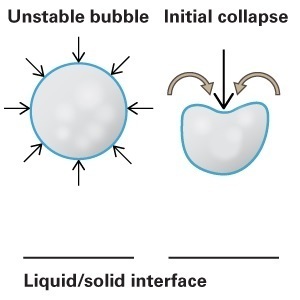Ultrasound 'making waves' for enhancing biofuel production

Iowa State University
June 7, 2013
BY Acoustical Society of America
All chefs know that “you have to break some eggs to make an omelet,” and that includes engineers at Iowa State University who are using high-frequency sound waves to break down plant materials in order to cook up a better batch of biofuel. Research by David Grewell, associate professor of agricultural and biosystems engineering, and his colleagues Melissa Montalbo-Lomboy and Priyanka Chand, has shown that “pretreating” a wide variety of feedstocks (including switch grass, corn stover, and soft wood) with ultrasound consistently enhances the chemical reactions necessary to convert the biomass into high-value fuels and chemicals.
In one example of ultrasound’s positive impact on biofuel production, the Iowa State researchers found that they could significantly increase the efficiency of removing lignin from biomass in solution. Lignin is the chemical compound that binds cellulose and hemicellulose together in plant cell walls. Commonly, enzymes or chemicals are used to remove it from biomass and allow the freed sugars to be dissolved for further processing into biofuel. Grewell and his colleagues found that pretreating instead with ultrasound makes lignin removal so efficient that sugar dissolution occurs in minutes rather than the hours needed with traditional mixing systems.
Advertisement
Advertisement
Grewell’s team also found that hydrolysis of corn starch could be greatly accelerated using ultrasonics. In a conventional ethanol plant, ground corn is steamed with jet cookers at boiling point temperatures. This breaks down the corn, leaving a starch mash that is then cooled and treated with enzymes in a process known as hydrolysis to release glucose for fermentation. The Iowa State team replaced the initial steaming with ultrasound, sonically smashing the corn into tiny particles in the same way physicians use ultrasound to shatter kidney stones. The smaller corn fragments provided more surface area for enzymatic action, and therefore, resulted in fermentation yields comparable to jet cooking.
The potential cost savings for this method, says Grewell, are very encouraging. “Economic models,” he explains, “have shown that once implemented, this technology could have a payback period of less than one year.”
Advertisement
Advertisement
Grewell and his colleagues report a third application for ultrasound in biofuel production, showing that they can accelerate transesterification, the main chemical reaction for converting oil to biodiesel. In one case, the researchers found that subjecting soybean oil to ultrasound transformed it into biodiesel in less than a minute, rather than the 45 minutes it normally takes. Similarly, Grewell’s team found that yeast populated with sugar and starved with glycerin, a co-product of biodiesel production, could prodfuce high yields of oil that could be extracted and simultaneously converted to biodiesel with ultrasonics in less than a minute. This is a dramatically faster and less complicated method than traditional techniques requiring multiple steps and relatively long cycle times.
Related Stories
The U.S Department of Energy Bioenergy Technologies Office, in partnership with the Algae Foundation and NREL, on July 21 announced the grand champion and top four winning teams of the 2023 - 2025 U.S. DOE AlgaePrize Competition.
The USDA significantly increased its estimate for 2025-’26 soybean oil use in biofuel production in its latest World Agricultural Supply and Demand Estimates report, released July 11. The outlook for soybean production was revised down.
U.S. fuel ethanol capacity fell slightly in April, while biodiesel and renewable diesel capacity held steady, according to data released by the U.S. EIA on June 30. Feedstock consumption was down when compared to the previous month.
The U.S. EPA on July 8 hosted virtual public hearing to gather input on the agency’s recently released proposed rule to set 2026 and 2027 RFS RVOs. Members of the biofuel industry were among those to offer testimony during the event.
The USDA’s Risk Management Agency is implementing multiple changes to the Camelina pilot insurance program for the 2026 and succeeding crop years. The changes will expand coverage options and provide greater flexibility for producers.
Upcoming Events










